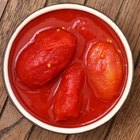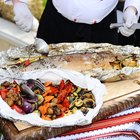
You like homemade food, but you're pressed for time -- everyone is. Believe it or not, with a little planning, you can have time to make the home-cooked meals you've dreamed about. The secret is making big batches ahead of time, then portioning foods out so your family can enjoy them at a moment's notice. If you make and store many different things, you'll have both ease and variety -- and you'll save money.
Refrigerator Storage
After you've made your favorite dishes and allowed them to cool to room temperature, pack portions in the sizes your family likes to eat. For example, if there are four people in your family, and you always eat meals together, pack enough food for a single meal for your family together. For ease of reheating, pack in containers suited to the method you'll use to reheat. If you'll use the microwave, pack food in lidded microwave-safe containers. If you'd prefer to use the oven, use an oven-safe ceramic or glass container with a tight-fitting lid. Repeat this process for each meal component you want to store.
Freezer Storage
Cool your food to room temperature before packing, just like storing food in the refrigerator. If you won't be freezing your food for a long time, you can use freezer-safe plastic or glass containers. However, if you don't know how long you'll be freezing your food, consider investing in a vacuum sealing machine. These machines are used with special rolls of plastic that can be cut to fit and form bags for any size of food. Some of these machines also have hoses that attach to special vacuum-lidded containers for wet foods, like soups and stews. This technology can be an investment at first, but it will save your food from freezer burn. If you use it regularly, this machine will pay for itself, because you won't have to throw away ruined food.
Labeling
Whether you store your food in the refrigerator or freezer, you should make a habit of always labeling it thoroughly. Use fancy labels or masking tape and a marker; it doesn't matter, as long as you label it with the name of the food and the date that you're packaging it. If you store any food in resealable storage bags, many of them have spaces printed on them for you to write the contents down. That way, you'll reduce the risk of those mystery containers filled with unidentifiable food at the back of the refrigerator.
First In, First Out
Your home kitchen isn't a restaurant kitchen, but one good rule of thumb from restaurants that you should apply is the "first in, first out rule." Packaging and labeling your food ahead of time is half the battle. As a good food safety practice, don't keep cooked foods in your refrigerator for longer than a week. Many foods will keep well in your freezer for six months or longer, but once you've defrosted them and are keeping them in your fridge, use the one week rule. It's OK to alternate between prepackaged meals, but if you have two batches of chicken parmigiana, use the one with the oldest date before you use the one you made yesterday.
Related Articles

How Long Is Leftover Spaghetti Good to ...

How to Freeze Honey-Baked Ham & Roasted ...

What Information on a Food Label Is ...
How Long Are Canned Meat & Vegetables ...

Ways to Keep in Touch With Your Friends

Can You Cook Frozen Foods That Are Past ...

Can You Freeze Canned Diced Tomatoes?

How to Cook Foil Packs in the Oven

Guidelines For Refreezing
How to Pack a Suitcase

How to Preserve Food for Display

Can I Make Sausage-Stuffed Puff ...

How to Mail Packages to Troops in Iraq ...

The Best Way to Pack a Silk Dress

How to Make Dinners Ahead of Time Using ...
Quick Easy Meals for a Group of 50 Kids

How to Store Dehydrated Foods

Creative Ways to Say Thank You to My ...

How to Package Cupcakes for Shipping

Thank You Note Etiquette for Envelopes
References
- "The Professional Chef," The Culinary Institute of America; 2006
- "ServSafe Coursebook, Fourth Edition," NRA Educational Foundation; 2006
Writer Bio
Amrita Chuasiriporn is a professional cook, baker and writer who has written for several online publications, including Chef's Blade, CraftyCrafty and others. Additionally, Chuasiriporn is a regular contributor to online automotive enthusiast publication CarEnvy.ca. Chuasiriporn holds an A.A.S. in culinary arts, as well as a B.A. in Spanish language and literature.
Photo Credits
BananaStock/BananaStock/Getty Images